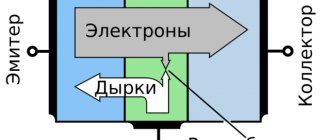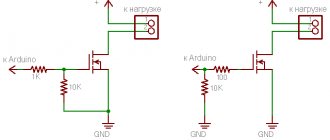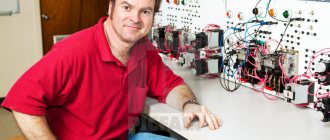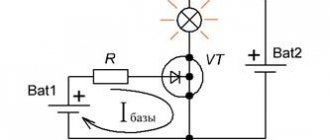History of transistors. Petrels of the Silicon Revolution
VLADIMIR GAKOV, journalist, science fiction writer, lecturer. Graduated from the physics department of Moscow State University. Worked at a research institute. Since 1984 in creative work. In 1990-1991 – Associate Professor, Central Michigan University. Since 2003 he has been teaching at the Academy of National Economy. Author of 8 books and more than 1000 publications
History of transistors Stormbirds of the silicon revolution
A ridiculous mistake led to a discovery that earned its authors a Nobel Prize.
More than sixty years ago, on December 23, 1947, three American physicists, William Shockley, John Bardeen, Walter Brattain, demonstrated to their colleagues a new device - a semiconductor amplifier, or transistor. It was smaller, cheaper, stronger and more durable than radio tubes, and in addition, consumed much less energy. In a word, the discovery became a real Christmas gift from the three “Santa Clauses” to humanity - it was with this basic element of integrated circuits that the Great Silicon Revolution began, which led to the emergence of the “personal devices” that are generally accepted today.
| William Shockley, John Bardeen and Walter Brattain |
All three received a well-deserved Nobel Prize, and Bardeen subsequently managed to receive a second one - in 1972, for creating the microscopic theory of superconductivity (together with Leon Cooper and John Schrieffer - more on that below). The fate of William Shockley was generally very interesting.
Technological Progress Booster
The history of the invention of semiconductor amplifiers - transistors - was dramatic, despite its transience. It all fit into the two post-war decades, but there was so much that wasn’t in it! Here are the amazing “flights” of the competitors of the lucky trio: being literally centimeters from the discovery, they did not see it and passed by, including the Nobel Prize that was shining on them. The students mastered the teacher’s ideas so well that they almost left him without the said “Nobel Prize,” so the disgruntled boss had to do the impossible in a week to catch up with his overly nimble team. And the transistor itself was born, as often happened, as a result of an absurd mistake by one of the heroes of this story, exhausted by a protracted streak of failures. And, finally, the no less amazing “blindness” of the mass media, which reported on one of the main technological revolutions of the twentieth century... in small print on the back pages!
The fate of two participants in the historical event is dramatic. Having lost interest in the gold mine they had discovered, both switched to other directions. But Bardeen, as already mentioned, received a second Nobel Prize (there were plenty of them in this story), and Shockley received public indignation and ignorance of the entire scientific community. Before that, he had already lost his best employees. Having escaped from his company and created their own, they became rich and became famous as the creators of the first integrated circuits.
This is not an article - it’s time to write a fascinating novel!
But everything is in order. So, by the middle of the last century, the question of replacing bulky, capricious, energy-intensive and short-lived vacuum tubes with something more miniature and efficient was on the agenda. Several scientists and entire research groups were simultaneously selected to solve this problem.
| History of transistor development |
Although it all started even earlier - in 1833, when the Englishman Michael Faraday discovered that the electrical conductivity of silver sulfide increases when heated. Almost a century later, in 1926, Faraday’s compatriot Julius Edgar Lilienfield received a patent entitled “Method and Apparatus for Controlling Electric Currents,” actually anticipating, but never building, the transistor. And after the end of World War II, specialists from the research company Bell Telephone Laboratories, whose headquarters were located in Murray Hills (New Jersey), began studying the electrical conductive properties of semiconductor materials.
It was there that, under the leadership of the prominent theorist William Shockley, one of the first “think tanks” in the history of American science was created. Even before the war, Shockley tried to solve the problem of increasing the conductivity of semiconductors using an external electric field. The sketch of the device in the scientist’s work journal for 1939 was very reminiscent of the current field-effect transistor, but the tests then ended in failure.
By the end of the war, many of Shockley’s colleagues and, most importantly, potential customers and investors - big business and the defense industry - managed to believe in semiconductors. They were impressed by the radars developed during the war, which were based on semiconductor detectors.
First of all, Shockley invited his former classmate, theorist John Bardeen, to Murray Hills, luring him away from the university in a simple way: he offered him twice the salary. In addition to the two of them, the group included five more specialists: a theorist, two experimentalists, a physical chemist and an electronics engineer. The captain of this team of scientists set before them the same problem that he struggled with before the war.
However, the second attempt also led to a negative result: even strong external fields could not change the electrical conductivity of semiconductor silicon wafers. True, this time Bardeen, who worked in conjunction with experimenter Walter Brattain, with whom he had become friends in college (where they were united not only by work, but also by a common hobby - golf), was able to at least explain the reason for the failure.
Without going into technical details, it follows from the theory of so-called surface states that he created that the control metal plates with which scientists influenced the semiconductor sample could not give the desired effect. To obtain a positive result, they should have been replaced with pointed (needle) electrodes.
Friends and colleagues did just that, and again nothing. It seemed that the matter had reached a dead end, but then the complete workaholic Brattain, about whom it was said that he could turn the knobs of an oscilloscope 25 hours a day (“just so he had someone to chat with”), unexpectedly lost his temper and made an unforgivable mistake for a professional. What he connected wrong there and what poles he mixed up can only be understood and appreciated by a physics specialist; for the rest of humanity, the result of that unfortunate mistake, which has become truly golden, is important. Having connected the electrode in the wrong place, Brattain was surprised to see a sharp increase in the input signal: the semiconductor worked!
Failed premiere
The first who immediately appreciated the beauty of the mistake made was Bardin. Together with Brattain, he continued moving in the “wrong” direction, starting to experiment with a germanium crystal that had greater resistance than silicon. And on December 16, 1947, friends demonstrated to the rest of the group the first semiconductor amplifier, later called a point-point transistor.
It was an ugly-looking germanium bar with curled antennae-electrodes protruding from it. How exactly it works, at that time, apparently, only Bardeen understood: the hypothesis he put forward in hot pursuit about the injection (emission) of charges by one electrode (emitter) and their collection by another electrode (collector) was listened to by his colleagues in bewildered silence. The experts could understand that they had to wait years for confirmation of Bardeen’s theoretical correctness.
The official presentation of the new device took place a week later, on Tuesday before Christmas, December 23, and this date went down in history as the day the transistor effect was discovered. The entire top management of Bell Telephone Laboratories was present, immediately appreciating what mountains of gold the new invention promised to the company - especially in radio communications and telephony.
| Modern transistors |
Only the group leader, consumed by jealousy, was in a gloomy mood. Shockley considered himself the author of the idea of the transistor; he was the first to teach his lucky students the basics of the quantum theory of semiconductors - however, no patent office would have been able to see his direct contribution to the creation of the first working transistor even with a magnifying glass.
It was doubly unfair that Shockley was the first to appreciate the absolutely fantastic prospects that the transistor promised in another area - rapidly progressing computer technology. The Nobel Prize was definitely on the horizon, and Shockley, possessed of ambition and morbid self-esteem, made a fantastic dash to catch the departing train. In just a week, the scientist created the theory of injection and a more thorough theory of the transistor than Bardin's - the so-called theory of pn junctions. And on New Year’s Eve, when my colleagues were mostly examining champagne bottles left over from the Christmas festivities, I came up with another type of transistor - a planar transistor (also called a “sandwich”).
The heroic efforts of the ambitious Shockley were not in vain - eight years later, he shared the coveted Nobel Prize with Bardeen and Brattain. At the celebrations in Stockholm, by the way, the whole trio got together for the last time and never met again in full force.
Six months after the successful premiere of the transistor, a press presentation of the new amplifier took place in the company's New York office. However, the media reaction, contrary to expectations, turned out to be more than sluggish. On one of the last pages (46th) of The New York Times newspaper dated July 1, 1948, a short article appeared in the “Radio News” section - and that’s all. The message was clearly not intended to be a global sensation - since the end of June, all American and world media were busy discussing another news - the Soviet blockade of West Berlin, which began a week before the presentation of the transistor. The invention of the three scientists paled against the background of reports about the “air bridge” with which the Americans delivered food and other essentials to the blockaded sector of Berlin.
At first, Bell Telephone Laboratories had to distribute licenses for transistors to everyone without bargaining. Demand was small - at that time, investors, by inertia, were still investing huge amounts of money in ordinary radio tubes, the production of which was experiencing a boom. However, there were individuals who quickly recognized the possibilities of new solid-state amplifiers, primarily in an unexpected area - hearing aids.
Microelectronics and macroeugenics
Among others, another future Nobel laureate was present at the New York presentation - at that time an engineer at the small company Centralab, Jack St. Clair Kilby. Inspired by what he saw, he set up the production of the world's first miniature hearing aids using transistors in his company. And in May 1958, Kilby moved to Dallas and went to work at Texas Instruments, which produced transistors, capacitors, resistors and other “cubes” from which electrical circuits are assembled.
When most of the employees went on vacation in the summer, Kilby was left to sweat in the office as the new guy. Among other things, he had to do routine work related more to business than to physics. It was while analyzing the pricing of semiconductor production that the scientist came across a brilliant idea, fundamentally purely economic. It turned out that in order to bring the production of semiconductors to the level of profitability, the company should have limited itself to the production of semiconductors alone. And all other active elements of the circuit should be produced on the basis of the same semiconductor, and already connected into a single compact structure like a children's game Lego! Kilby figured out exactly how to do it.
The company's management was delighted with the employee's idea and immediately “loaded” him with an urgent task: to build a pilot model of a circuit made entirely of semiconductor. On August 28, 1958, Kilby demonstrated a working trigger prototype, after which he began manufacturing the first monolithic integrated circuit (phase-shift oscillator) on a germanium crystal.
The first ever simple microchip, the size of a paper clip, went into operation on September 12, and this day also went down in history. However, Jack Kilby had to wait almost half a century for the Nobel Prize - the scientist received it in the last year of the twentieth century, sharing the prize with his compatriot, a native of Germany, Herbert Kremer and his Russian colleague Zhores Alferov.
As for the personal and professional destinies of the three fathers of the transistor, they turned out differently. Bardeen, whom Shockley, who was jealous to the point of paranoia, began to openly “overwrite,” left Bell Telephone Laboratories in 1951 and went to work at the University of Illinois at Urbana. An additional incentive was the rare annual salary of $10 thousand in those days. Five years later, Professor Bardeen, who had already forgotten about semiconductors and switched to quantum systems, heard on the radio that he had been awarded the Nobel Prize. And in 1972, as already mentioned, he received a second one for the microscopic theory of superconductivity he created together with his collaborators Leon Cooper and John Schrieffer. The only two-time Nobel Prize laureate in history (in the same category!) died in 1991 at the age of 82.
| Andi Grove, Robert Noyce and Gordon Moore |
For Walter Brattain, who died four years earlier, the point-point transistor remained the pinnacle of his scientific career.
But their leader, William Shockley, even after receiving the award, actively worked in various fields, although he soon abandoned transistors. It is curious that from a technological and commercial point of view, his planar transistor turned out to be more promising than the point transistor of Bardeen and Brattain: the latter lasted on the market only until the end of the 1950s, while planar transistors are still produced today. And it was on their basis that the first microcircuits were created.
But most of all, Shockley became famous in a field very far from physics. And according to many, from science in general. In the mid-1960s, he unexpectedly became interested in eugenics, which evokes in many unpleasant associations with Aryan supermen, inferior races and similar “hellos” from the recent past. Shockley developed his own modification of eugenics - dysgenics. This theory speaks of the inevitable mental degradation of humanity, in which the intellectual elite (people with high IQs) are washed out over time, and their place is taken by those whose lack of intelligence is compensated by an excess of reproductive function. In other words, more prolific and more stupid.
A sober-minded person could still agree with the idea of the general stupidity of humanity - in principle. However, Shockley added a racial element to his reasoning, including among the more fertile and stupider representatives of the black and yellow races, which, in his opinion, were born with a lower IQ than whites. The American physicist did not stop there and, in the spirit of the ever-memorable Nazi recipes, proposed his final solution - not only to the Jewish, but to the Negro question. To prevent the rapidly multiplying and mentally undeveloped “blacks” (as well as the “yellows” and weak-minded “whites”) from finally pushing the highly intelligent white elite to the margins of history, the latter should encourage the former to voluntary sterilization.
Shockley's plan, which he repeatedly presented to the American Academy of Sciences and government agencies, provided for financial incentives for people with low IQs who agreed to voluntary sterilization.
One can imagine the reaction of Shockley's colleagues to such revelations. In the 1960s, there was no need to talk about total political correctness in America, but outright racism was no longer in fashion. And when such ideas were presented by a professor and Nobel laureate, the result could only be shock and indignation. Shockley was completely obstructed by the intellectual elite until his last days (he died of cancer in 1989).
Silicon Valley geeks
Meanwhile, the story of the invention of the transistor did not end there. The circles from the historical event that occurred in December 1947 diverged for a long time, sometimes leading to completely unpredictable results.
In fairness, the aforementioned trio of Nobel laureates in 2000 - Kilby, Kremer and Alferov - should have been joined by the American Robert Noyce, who created the first microcircuit at the same time as Kilby. And most importantly - regardless of him. However, Noyce did not live to see the end of the century, and, as is known, this prize is not awarded posthumously.
But it is interesting that the first impetus for Noyce’s scientific career was given by the same Shockley - even before he finally “moved” on racial grounds. In 1955, the future Nobel laureate left Bell Telephone Laboratories and founded his own company, Shockley Semiconductor Laboratories, in the southern suburb of San Francisco, Palo Alto, where he spent his childhood. Thus the first stone was laid in the foundation of the legendary Silicon (or Silicon) Valley.
Shockley recruited young and early employees, without thinking about their ambitions or the limits of their patience - he had a disgusting character, and he showed himself to be no leader. Less than two years later, the psychological climate in the company became fraught with explosion, and eight of the best employees, led by Noyce and Gordon Moore, ran away from it to found their own company.
The “eight traitors” (as Shockley branded them) had more than enough brilliant ideas - which can’t be said about the start-up capital. Friends and partners of the not yet born company began visiting banks and investors in search of money. And after several refusals, we happily stumbled upon the same young and ambitious financier Arthur Rock, whose strong point was precisely attracting investments. What exactly the technical engineers “sang” to the businessman is unknown to history, but be that as it may, he played a truly fateful role in their future business. And also in the fate of other Silicon Valley companies, whose founders at the start did not have a penny to their name - only brilliant ideas and projects.
With Rock's help, the local company Fairchild Camera & Instrument agreed to invest $1.5 million in the new business, but with one condition: it would have the right to buy back in the future for twice that amount - if their business went uphill. This is how the Fairchild Semiconductor company was created, whose name literally translates as “Semiconductor of the Wonder Child” (in the German version - child prodigy). And the prodigies from Palo Alto soon made themselves known.
| First transistor | Modern microchip | Microchip |
Noyce considered himself an excellent lazy person. And he made the main invention of life, in his own words, also out of laziness. He was tired of watching how, in the manufacture of micromodules, silicon wafers were first cut into individual transistors, and then again connected to each other into a single circuit. The process was labor-intensive (all connections were soldered by hand under a microscope) and expensive. And in 1958, Noyce finally figured out how to isolate individual transistors in a crystal from each other. This is how the familiar microcircuits were born - plates with a graphic labyrinth of “tracks” made of aluminum coatings, separated from each other by insulating material.
At first, microcircuits had difficulty making their way to the market. But in the early 1970s, everything changed dramatically: after Fairchild Superconductor sold a certain type of microchip (predicted by Bardin while working at Bell Telephone Laboratories) for $15 million in 1969. Two years later, sales of the same products jumped to $100 million .
However, the successes of the “prodigies” were overshadowed by the usual priority squabbles in such cases. The fact is that Jack Kilby applied for a patent for the chip in February 1959, and Noyce did so only five months later. Nevertheless, he received a patent first - in April 1961, and Kilby - only three years later. After this, a ten-year “priority war” broke out between the competitors, which ended in a settlement agreement: the US Court of Appeals confirmed Noyce’s claims to primacy in technology, but at the same time ruled that Kilby was considered the creator of the first working microcircuit.
Robert Noyce did not live to see his rightful Nobel Prize in 2000 exactly ten years - at the age of 63, he died in his office from a heart attack.
But before that, he founded another famous company with Moore. Having abandoned their established business at Fairchild Semiconductor in 1968, the friends decided to name their new brainchild without any fuss: Moore Noyce. However, in English it sounded more than ambiguous - almost like more noise (“more noise”), and the partners settled on a more official, but meaningful name: Integrated Electronics. Then their company changed its name several times, and today every user of personal computers sees its logo every day with its current name, short and sonorous - Intel. Which is "inside".
Thus, two decades after the discovery of Bardeen, Brattain and Shockley, the Great Silicon Revolution ended.
Application
Convention breaker
In the case of John Bardeen, members of the Swedish Academy, for the first and so far only time in the more than century-long history of the Nobel Prizes, violated its statute. One of its clauses prohibits awarding prizes twice in the same category. However, it would be simply indecent to celebrate the success of Bardeen’s collaborators (obvious to the members of the committee and the entire world scientific community) and at the same time ignore the main hero of the occasion, and the American physicist was made an exception.
There was clearly no desire for sensation...
“Yesterday Bell Telephone Laboratories demonstrated for the first time a device it has invented called a transistor, which in some cases can be used in the field of radio engineering instead of vacuum tubes. The device was used in a radio receiver circuit that did not contain conventional lamps, as well as in a telephone system and a television device. In all cases, the device worked as an amplifier, although the company claims that it can also be used as a generator capable of creating and transmitting radio waves. The transistor, which has the shape of a small metal cylinder about 13 millimeters long, is not at all like ordinary lamps; it has no cavity from which air is evacuated, no mesh, no anode, or glass case. The transistor turns on almost instantly, without requiring heating, since it does not have a filament. The working elements of the device are only two thin wires connected to a piece of semiconductor the size of a pinhead, soldered to a metal base. A semiconductor amplifies the current supplied to it through one wire, and the other removes the amplified current.”
The New York Times, July 1, 1948
What are the differences between different transistors?
Using a simple transistor as an example, we analyzed its operating principle, but there are a great many of them. Let's learn to distinguish them and find out why each of them is needed.
Bipolar
Bipolar transistors are the most popular. In a semiconductor, such transistors have two pn junctions. Charge is transferred through them by holes and electrons.
Among them, there are also several subtypes (they depend on the location of the transitions and the number of electrodes), including:
- compound transistor pnp type;
- composite transistor npn type;
- more complex multielectrode ones (there can be 2 emitters at once);
- heterojunction transistors.
Avalanche transistors
This is a truly interesting type of transistor because it works very efficiently and at the same time very quickly. Their main advantages are high operating voltages and, of course, turn-on speed, and this is very important in electronics. Scientists are still puzzling over how to use these transistors with maximum efficiency, although they are still showing amazing results.
Unijunction transistors
There are such transistors in the world. There is only one transition, so the classification is much simpler:
- the first type is with a “p” base;
- and the second one is with “n” base.
Transistors with control junction
This is also a very interesting and unusual type of transistor, because, as the name suggests, it has a controlled transition, which makes it even more universal, but also makes it more expensive. We will not dwell on the subspecies, as they are all approximately the same as the previous ones.
Insulated Gate Transistors
And what kind of shutter is this, you might think. I'm telling you. As I wrote above, the transistor starts working when a small voltage is applied to it. So, the electrode to which voltage is applied is called a gate. There is nothing special here, it’s just that the gate itself is isolated, which gives more opportunities to control the transistor and for some tasks this is indeed very useful.
Now that we know quite a lot about transistors, we invite you to delve into history and find out how that Darlington transistor came to be.











